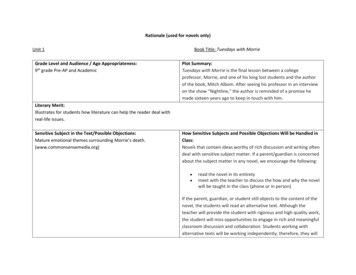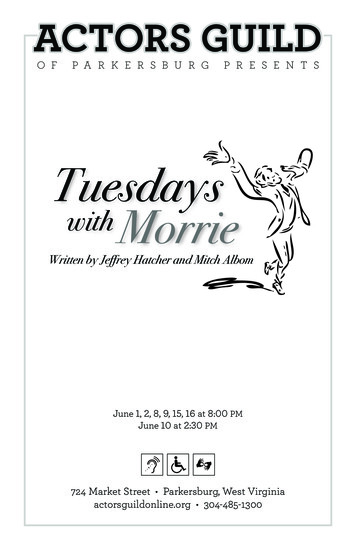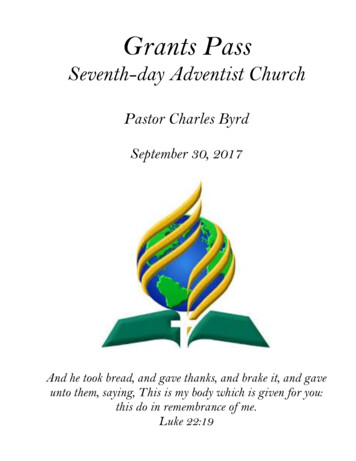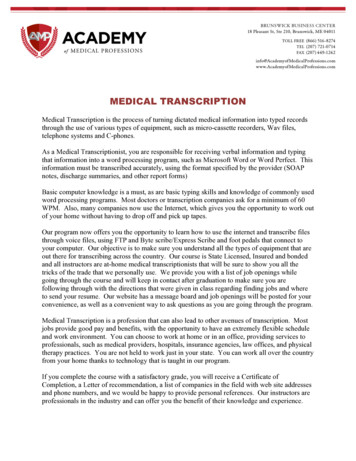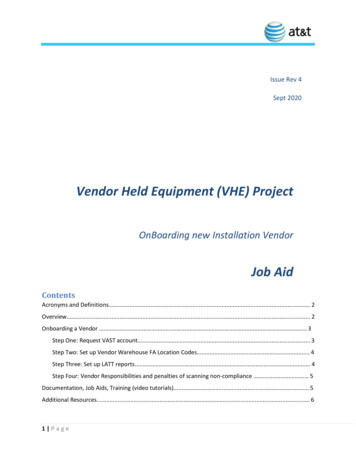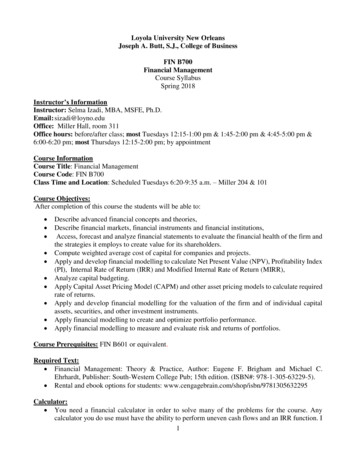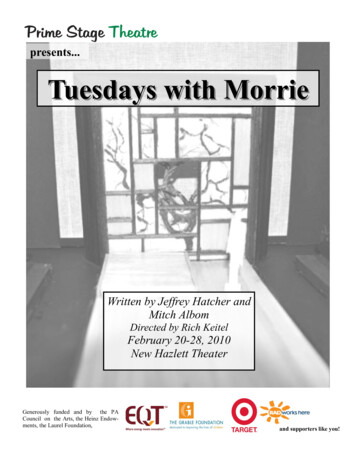
Transcription
presents.Tuesdays with MorrieWritten by Jeffrey Hatcher andMitch AlbomDirected by Rich KeitelFebruary 20-28, 2010New Hazlett TheaterGenerously funded and by the PACouncil on the Arts, the Heinz Endowments, the Laurel Foundation,and supporters like you!
Tuesdays with MorrieResource GuideWestern PA Educators—The Best of the BestDear Educator,After an extremely successful and critically acclaimed run of Our Town,Prime Stage Theatre isback to bring you themodern classic, Tuesdayswith Morrie. After sailingto the top of the NewYork Times Best SellersList, this book about aman who reconnects withhis teacher/mentor, Morrie, as he begins the process of dying hits a chordwith anyone involved inthe education profession.What impact have wemade on a young person‟slife? How often are we—or are students—aware ofthe powerful influence wehave on not only theircontent education but ontheir life education?Iwould argue that whilethis awareness can getlost amidst testing andteenage drama, that eachof us can remember ateacher who helped us ininvaluable ways to become a better student andperson. And now PrimeStage Theatre has a wayto recognize those educators like you who aremaking a difference inthe field of adolescentliteracy. The first annual“InspiringTeachers—Inspiring Readers” awardwill be given in honor ofone local teacher whocontinues to inspire his/her students to read.Nomination forms can bedownloaded on our website, www.primestage.com,and will be acceptedthrough February 1,2010.Self-nominationswill be accepted.Theselected recipient willreceive two (2) seasonVolume 1, Issue 21.11.2010Did you know Our Town, PST 2009subscriptions to the 201011 Prime Stage season, aone-yearALAN(Assembly on Literaturefor Adolescents) membership, and a special gift.The recipient will be honored at a special receptionon Friday, February 26. AlyssaHerzogEducation DirectorArts and Humanities:9.1-9.4Reading, Writing,Speaking, & Listening:1.1-1.8History: 8.1-8.4Economics: 6.2Family & ConsumerScience: 11.2http://primestage.ning.com Prime Stage Theatrewants to hear yourthoughts about ourproduction! Visit theEducation page of ourwebsite,www.primestage.com,to access our teacherand student feedbackforms!Check out what’s inside!Curriculum Connections CornerPrime Stage Theatre iscommitted to directlycorrelating our programsto the PDE AcademicStandards. Tuesdays withMorrie and this resourceguide may be used to address the following curriculum content standards:Prime Stage Theatrehas an online networking community forteachers? Check usout at:Health, Safety, andPhysical Education: 10.2Show Summary;Mitch Albom2ALS;Meet the People3Before the Show;Vocabulary4House Rules;During the Show5Post Show Activities6Discussion Questions; 7Additional Resources
Page 3Tuesdays with MorrieBefore the ShowTuesdays with Morriein 30 seconds As a world-famous, jet-setting sportsjournalist and husband, Mitch Albomkept moving forward with his life at abreak-neck pace. He had little time tokeep—or for that matter even thinkabout—the promise he had made to hisesteemed sociology professor, MorrieSchwartz, on the day of his graduation:“to keep in touch.” Since his graduation from Brandeis University, Mitchtried but eventually gave up his dreamof becoming a jazz musician and instead took up writing about sports. Hemoved to Detroit, met all the people ontop of the world, and craved the materialistic lifestyle of those he met. YetMorrie stayed right in Waltham, Massachussetts. And while Mitch was fail-ing to stay in touch, Morrie still taughtnew and fresh faces every fall, changing lives one biting comment at a time.Morrie‟s perspective changed drastically, however, when he was diagnosedwith ALS, or Lou Gherig‟s disease.Since the diagnosis, Morrie vowed tolive through the process of dying, recording his wisdom on sheets of paper.His loving attention to dying caughtthe eye of the media, from newspapersto Nightline with Ted Koppel. And itwas during one of these television airings that Mitch stumbled upon his old,dear professor. Morrie‟s humor andsensibility compelled Mitch to finallykeep his promise to Morrie. While hedidn‟t know it upon his first visit, thesereturns every Tuesday to the home ofhis former professor would become private tutoring sessions, a last class—aMitch Albom—The AuthorMitch Albom was born on May 23,1958 to a middleclass family inPassaic, New Jersey. Interested inthe arts, Mitch turned first to cartooning and then to music. Hetaught himself how to play piano andwould perform with numerous bandsin high school and college. He attended Brandeis University, and itwas here that he was mentored bythe man who would later so drastically change his life—MorrieSchwartz. Mitch earned a bachelor‟sdegree in sociology in 1979. Aftergraduation, he went to New YorkCity where he pursued his dream ofbecoming a jazz musician. After volunteering for a local newspaper inQueens, however, he discovered yetanother passion—journalism. Mitchwent back for his masters in journalism and business at Columbia University while still playing the pianoto help pay for school. By the mid1980s with two graduate degreesunder his belt, his freelancing worklanded him a job at the Detroit FreePress. From here, his real-life successes mirror those he tells about inhis book. Mitch won several awardsfrom theSports Editorsof America(APSE) andcontinues to bea regular onESPN andother TVshows. Healso cultivateshis love formusic, having written songs withWarren Zevon and the music for anArnold Schwarzenegger movie. 1995was an important year for Mitch. Henot only married his wife Janine, butalso re-connected with Morrie. Sincethen, Mitch has written numerousother bestsellers, including The FivePeople You Meet in Heaven, One MoreDay, and Have a Little Faith. Mitchalso puts into practice the lessons helearned from Morrie. He is the founder of three large charities: TheDream Fund, which helps disadvantaged kids become involved in thearts; A Time to Help, which sponsorsmonthly volunteer project aroundDetroit; and S.A.Y. Detroit, whichfunds homelessness initiatives.class about life. After Mitch loses hisjob during a newspaper strike, he vowsto capture every ounce of wisdom andadvice Morrie had about love and marriage, death and grief, and everythingin between. Mitch recorded their conversations and wrote the book as a testament to the man who was always “ATeacher to the Last.”.or less!Morrie Schwartz, a beloved professor atBrandeis University, teaches his formerstudent, Mitch Albom, to “not assumethat it‟s too late to get involved” inanother‟s life. Through revisiting hisprofessor every Tuesday until hisdeath, Mitch is given another chance tolearn and relearn what is important inlife: “love always wins.”Jeffrey Hatcher—The PlaywrightJeffrey Hatcher grew upin Steubenville, OH.First he aspired to be anactor, but after testinghis ground in New YorkCity, he decided to turnto playwriting instead.His work is also regularly featured atCity Theatre here in Pittsburgh, PA.His other plays include Three Viewings, Compleat Female Stage Beauty,Scotland Road, To Fool the Eye, Dr.Jekyll and Mr. Hyde, and The Turnof the Screw. His screenplays includeStage Beauty (2004), Casanova(2005), and The Duchess (2008).Here‟s why Jeffrey said he wasdrawn to adapting Tuesdays: “Myfather had died what they call a „baddeath‟ a few years before. I didn‟tthink I had done for my father what Icould have when he was dying.Thebook‟s reminder that there is alwaysthe possibility for change, of rebirthand regeneration held greatsway” (Seattle Rep Study Guide).
Volume 1, Issue 2Page 4ALSAmyotrophic lateral sclerosis (ALS) is a progressive neurodegenerative disease that causes motor neurons—whichreach from the brain to the spinal cord and throughout the body‟s muscles—to whither and die. Often referred to as"Lou Gehrig's Disease,” named after the famous baseball player who suffered from the disease, ALS leads to the brain‟sinability to initiate and control muscle movement. In later stages, this loss of muscle movement can make a patienttotally paralyzed.In the U.S., about 5,600 people are diagnosed with ALS each year, or about 15 new cases every day. Diagnosing peoplecan be very hard, however, as the initial symptoms of ALS can be quite varied in different people. Some experienceweakness in their hands, trip over the carpet, or notice a change in their speech patterns. But the hallmark initialsign of ALS is some form of muscle weakness, a symptom occurring in about 60% of the patients. Just like how theonset and initial symptoms of ALS may differ markedly from one patient to the next, the progression of ALS is alsohighly variable. Although the mean survival time with ALS is three to five years, many people live five, ten, or moreyears.Scientists are not entirely sure what causes ALS nor can they determine who is most atrisk. While 20% more men get the disease than women, 93% of the people in the UnitedStates ALS Database are Caucasian. While the average age of diagnosis is 55, ALS canstrike any one of any age of any ethnicity. There is not a cure or treatment for ALS; however, there is one FDA approved drug, riluzole, that has been shown to modestly slow theprogression of ALS.Prime Stage Theatre is partnering with the local Pittsburgh chapter of the ALS society.Staff from the local chapter will be attending rehearsals to ensure the authenticity of theactor‟s portrayal of the illness. For more information, please visit the national ALS Association Website at www.alsa.org or the Pittsburgh chapter‟s website at www.cure4als.org.Meet the PeopleCharacter: Morrie SchwartzCharacter: Mitch AlbomActor: Robert Haley has appeared at many regionaltheaters in Canada and the US, including the Stratfordand Shaw Festivals. He was awarded Best Actor recognition by the Toronto Theatre Alliance for performancesin Death and the Maiden and Singer. Here in Pittsburgh he has been seen in productions by QuantumTheatre, Pittsburgh Irish and Classical, Jewish Theatreof Pittsburgh, and the Playhouse Rep. Feature filmcredits include: a co-starring role with Lou DiamondPhillips in Hangman; Fast Company directed by DavidCronenberg; and The Shawshank Redemption. On TV,Robert has appeared in featured roles in the miniseriesJoan of Arc and the series Street Legal and The AvroArrow. Recently he worked on the films Smart Peopleand The Homecoming, which was filmed in Pittsburgh.Actor: Justin Fortunatois a Junior at Point ParkUniversity pursuing hisBFA in Musical Theatre. Point Park Creditsinclude: Gordon Miller inRoom Service (Point ParkConservatory ) Creon inAntigone (PPC), LutherRosser in Parade(PPC), Boris Adzinizinadzein Can-Can (PPC), FatherFrog in A Year With Frog and Toad(Playhouse Jr.), Gander in Charlotte's Web (PlayhouseJr.). Other roles include Man # 2 in Songs for a NewWorld (Seton Pioneer Theatre), Javert in Les Mis(Seton Pioneer Theatre), Sweeney Todd in SweeneyTodd (Carrnivale Theatrics).Post Show Chat Session—come with questions!After each matinee, audience members will be given an opportunity to chat with both thecharacters in the show—Morrie and Mitch—and with the actors themselves. Students shouldcome prepared with questions for both, or they can submit them to the Education Director ataherzog@primestage.com. Please include first name and school in email.
Page 5Tuesdays with MorriePre-Show ActivitiesPrime Stage‟s mission, bringing literature to life, encompasses not only students‟ interaction with a literary piece oftheatre, but also with the text itself. Prime Stage encourages all teachers to incorporate our production‟s text (in itsoriginal or dramatized form) into the curriculum. The activities below presume that students have read the text.1.Adapting a fiction or a non-fiction text to a play can be a tough task. How do you show a character‟s journey instead of tellabout it? Have students try their hand at adapting a small section of the book, Tuesdays with Morrie. Choose one of the books“lessons,” and have students identify the following: the most important information that is relayed in that lesson, the preexisting dialogue of that particular lesson, the conflict, (man v. man, man v. self, man v. society), the characters, and the setting. After finding this information, students should then re-write the lesson in dramatic format using dialogue and stage directions only. Students should feel free to add additional dialogue as they see fit in order to convey necessary information. Thenask students to share aloud their adaptations with one another and discuss the different choices made by different students andhow it affected the meaning of the scene they created. Also discuss the consequences of adapting a novel or book to a play—how“true” does it stay to the book and should it even have to stay true? What is lost and gained through adapting a story to a play?PDE Academic Standards 1.2-1.4, 9.12.Discuss with students the idea of an aphorism: a short saying embodying a general truth or astute observation. Have studentshunt through the text for some of Morrie‟s many aphorisms. Next, students should choose one aphorism and write a 1-2 pageessay on why they personally connect to it, why they believe in that aphorism, and how it has or could impact their life. Extension activity: students use an aphorism as inspiration for a piece of poetry or artwork. PDE Academic Standards 1.2-1.43.Have students research the Kubler-Ross stages of grief (www.grief.com). Students can present their findings in a desired format:poster, essay, diagram, oral presentation, etc. Next have students go through the book Tuesdays with Morrie and identify different stages that Morrie and Mitch go in and out of. Discuss with students their findings. How accurate are these stages? How dothe characters move from one stage to another? Extension Activity: Have students write about a time when they have grievedand to think about what stages they went through in dealing with their loss. How did they behave and why? PDE AcademicStandards 1.3-1.5, 1.8A quick quote from Morrie to ponder:Have you ever really had a teacher? One who saw you as a raw but precious thing, a jewel that,with wisdom, could be polished to a proud shine? If you are lucky enough to find your way tosuch teachers, you will always find your way back. Sometimes it is only in your head. Sometimes it is right alongside their beds (192).CARPE DIEM(or Seize the Day)The little bluebird on his shoulder thatMorrie refers to many times in thebook is a reflection of the ideal “CarpeDiem”. The Latin phrase originated inthe poem Odes 1.11 by the Roman poetHorace. In what ways do you “seizethe day?”Say that again?On average, a high-school graduatehas a vocabulary of 12,000-20,000words. A college graduate mighthave closer to 25,000. One can onlyguess how many words someonelike Morrie—a wise old college professor—had in his brain.Have students record unfamiliarwords as they encounter them inreading the book. Students shouldthen look up definitions in a dictionary. Vocabulary activitiescould include a word wall, wordball, or new sentence generation.PDE Academic Standards 1.1, 1.7-1.8 valiere icEgotisticalAmbivalenceClamoringNostalgia
Volume 1, Issue 2Page 6House rules (.and we don‟t mean your mama‟s house!)It goes without saying that when mostchildren today hear the word “theatre”they think “oh, MOVIE theatre.” Andwith that thought comes all of thosethings that we do at movie theatres: eatpopcorn, drink noisily from soda cups,put feet on the seat, text message—andthe list goes on from there. But livetheatre is just that: it‟s LIVE withLIVE HUMANS who react and respondto the audience, something that we atPrime Stage think is the beauty of thetheatre experience. Because of this,live theatre requires a higher level ofrespect between the audience and performer in order for the experience to bea positive one.Please review the following “houserules” with your students prior to attending Tuesdays with Morrie:—Please stay together with your group andwait for the ushers to help you all find yourseats.—Please turn all cell phones and pagerscompletely off before the performance. Ifyou are texting during the performance,you will be asked to leave.—No photography or video taping.—While we encourage active listeningand appropriate responses to the play suchas laughing or clapping, please do not talkto your neighbors during the performance.—Please stay in your seat until the intermission or the end of the show.—Be polite and attentive. Show yourappreciation by clapping—the actors loveto see how much you enjoyed the show!PDE Academic Standards 1.6, 9.1—No eating, drinking, or chewing gumduring the performance or inside the theatre house.Johnmichael Bohach, the scenic designer for Tuesdays with Morrie, drew upon oneprevailing image from the book—the Japanese Maple. This led him to investigateEastern aesthetic traditions, including meditation rooms and the Shoji screen, whichgained prominence and popularity in the United States after renowned architectFrank Lloyd Wright brought them back from Japan and began using them as a vitalelement in creating a “whole living environment”. From the rendering to the right,how does the set make you feel? Does it fit with your interpretation of the book?I would rather be attacked than unnoticed. For the worst thing you can do to an author is to be silent as to his works. An attack upon a town is a bad thing; but starvingit is still even worse. author Samuel Johnson (1709-1784)1.Read the following questionsbefore the show.2.Think about the questions asyou‟re watching the show and writeyour answers in a notebook or journal during intermission or on thebus ride home.Write a critique of the show basedon your responses.PDE Academic Standards 9.1-9.4,1.4-1.53.Actor choices—How did theymove and speak? Did they seemlike people we know? How didthey relate to other characters?Designer choices—What designelement captured your attentionthe most—the set, costumes,lights, or sound—and why? Howdid the design elements work together to support the entire production? What choices did thedesigners make in materials, colors, intensity, detail, etc.? Werethe design elements more descriptive or suggestive? What symbolsdid you find in the design elements?Director choices—What was thestyle, pace, and rhythm of theplay? What stage pictures helpedto tell the story? How did theDuring the Show4.5.6.director unify all the elements ofthe production?Interpretation—Did the directormake a statement about life now?How did the characters, design,and play make you feel? Whatdid the play mean to you? Whatmight it mean to others?Evaluation—Why do you supposethe playwright wrote the play?Why was the play produced now?When were moments where thestorytelling was very clear?When were moments you wereconfused about the story? Whowould enjoy the play and why?Tuesdays with Morrie specificquestions—How did the stageadaptation successfully reflect thebook? How were the transitionsbetween scenes shown?
Page 7Tuesdays with MorriePost-Show Activities1. The Varieties of Death: The view of death in different cultures and religions varies widely, from a finite end point to a beginning of everlasting life. Have your students investigate the philosophy of deathin different world religions, such as Christianity, Judaism, Buddhism, Islam, Humanism, Sikhism, andHinduism. Students should conduct research on both the beliefs about death and the rituals which surround death. Students can then report on their findings in numerous ways—essay, handbook, pamphlet, etc. PDE Academic Standards 1.5, 1.8, 8.1-8.42. Bridges: Morrie often referred to himself as a bridge, a person who is in between life and death, whichmakes him useful to others as a tool to understand both. Have students brainstorm other literary, historical, political or religious figures who have also served this purpose, who have left a legacy throughboth their life and their death. Next, have students choose one figure and research that person, focusing on their words and actions that still live in people‟s memories. Students can present their researchin numerous ways—essay, poster, webpage, etc. PDE Academic Standards 1.5, 1.8, 8.1-8.43. Dying in America: Surveys indicate that, if given the option, over 70% of Americans would choose todie in their homes surrounded by family and friends. The financial and emotional burden on familymembers can sometimes not make this viable. Have students investigate end-of-life care options here inAmerica for “anticipated” deaths, including at-home family care, hospice care, and nursing homes. Students should focus on finding statistics about each and should generate a list of pros and cons for each.Extension Activity 1: Break the students up into groups and hold a debate that lobbies for each type ofcare. Extension 2: Have students write a personal essay on which option they would like for themselvesand/or their parents and the anticipated effects on themselves and their family members.PDE Academic Standards 1.6, 1.8, 11.24. Create Your Own Culture: Morrie believed, "You have to be strong enough to say if the culture doesn't work, don't buy it. Create your own." First discuss with students how can people do this and in whatways, if any, this book helped to do that. Then ask students to brainstorm parts of their culture thatwork and don‟t work. What aspects of your culture would you change if given the opportunity? Howcould these changes be implemented? Lastly, ask student to do exactly what Morrie said: using theparts of their own culture they don‟t like, they should create their own. Have students write about whatthey have learned from Morrie's teachings and outline a new set of cultural values by which they willbegin leading their lives. Reflection questions: How can culture be individualistic, and how is it shared?How do you participate in “buying” culture ? Are you what you “buy”? PDE Academic Standards 6.3, 8.35. Conflict Resolution Role-Play: Discuss with students the practical side of Morrie's advice: "Only anopen heart will allow you to float equally between everyone." How can we allow ourselves to have anopen heart? What does Morrie mean by “floating equally” between everyone, and is this an attainablegoal? How could this advice be useful the next time you're in a social or other situation where you feelout of place or uncomfortable? Next, have students role-play in partners one of the following scenarioswhile taking into consideration Morrie‟s “open heart” rule. PDE Academic Standards 10.2Scenario #1: Partner A is in the “popular crowd” at school. Partner B is the new kid at school. B says something that, while acceptable back at his old school, is not acceptable to the “popular” kids. A‟s friends want toput B in his place, but A feels uncomfortable. What does A say to his friends and to B? How does B respond?Scenario #2: Partner A is a student riding home from school on public transportation. Partner B is an elderlyperson who sits down next to A on the bus. A notices that B has been crying. B notices that A is sighing alot. Then, as people are clamoring to get on the bus, someone knocks into B and B begins to cry again. Howdoes A respond? How does B respond?Scenario #3: Partner A and Partner B are two students who are rushing to get to their next period, and theybump into each other in the hallway. A apologize profusely, but B gets very angry and is about to throw a bookat A. How does A respond? What is done to defuse the situation?
Discussion Questions1. Did your opinion about Mitch change as the book went on? In whatway?2. Who do you think got more out of their Tuesday meetings, Mitch orMorrie? In what ways? How do you think each would answer thisquestion?Prime Stage TheatreNew Hazlett Theater6 Allegheny Sq. EastPittsburgh, PA 152123. Discuss Morrie's criticisms of Mitch throughout the book. Do youthink Morrie should have been tougher on him? Easier?Phone: 412-773-0700E-mail: studentmat@primestage.com4. Does this book make Morrie's death a public event? If so, how is itsimilar to other public deaths we've experienced as a society? How is itdifferent?5. Mitch made a list of topics about which he wanted Morrie's insightand clarity. In what ways would your list be the same or different?6. To the very end, Mitch arrived at Morrie's house with food. Discussthe importance of this ritual.Words of Wisdom from Morrie 7. Would Morrie's lessons have carried less weight if Mitch and Peterhadn't resumed contact by the book's end? PDE Academic Standards 1.3, 1.6 Don’t assume that it’s too late to getinvolved (18).The most important thing in life is tolearn how to give out love and to let itcome in (52).Sometimes you can’t believe what yousee; you have to believe what you feel(61).Be compassionate. And take responsibility for each other. If we only learnedthese lessons, this world would be somuch a better place (163).Resources for your ClassroomBOOKS and RECOMMENDED READINGVIDEOSAlbom, Mitch. The Five People You Meet In Heaven. Hyperion, **Videos can be found in the Carnegie Library system.**2003.Morrie: Lessons on Living. 59 minutes. ABC News ProducAngelou, Maya. Wouldn’t Take Nothing for My Journey Now. tions, 2005, VHS/DVD.NY: Bantam, 1994.Tuesdays with Morrie. 89 Minutes. Buena Vista Home EnterDidon, Joan. The Year of Magical Thinking. NY: Knopf, 2005. tainment, 2003, DVD.Fulgham, Robert. All I Really Need to Know I Learned in Kindergarten. NY: Ballantine, 2003.WEBSITESGaines, Ernest. A Lesson Before Dying. NY: Random House,www.alsa.orgInc., 1993.www.foronemoreday.comKubler-Ross, Elizabeth. On Death and Dying. chives.aspxRoutledge, 1969.http://repstl.org/studyguides/Schwartz, Morrie. Morrie: In His Own Words. Delta, ide.htmlWE WANT YOUR FEEDBACK!Teacher and students can now fill out their own feedback forms on Prime Stage’s website:http://www.primestage.com/education.htm. Fill out a survey and be entered to win 2 freetickets to the next Prime Stage production!
his book. Mitch won several awards Tuesdays with Morrie in 30 seconds As a world-famous, jet-setting sports journalist and husband, Mitch Albom kept moving forward with his life at a break-n
